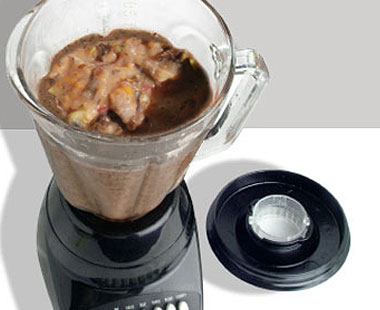 Garbage smoothie. Feeding a bin full of worms is delicate business. There’s portion size to consider, and how often to feed. You must bury the scraps just so in order to elude marauding flies. Soil acidity, oxygen levels, and moisture content must be carefully balanced.
Garbage smoothie. Feeding a bin full of worms is delicate business. There’s portion size to consider, and how often to feed. You must bury the scraps just so in order to elude marauding flies. Soil acidity, oxygen levels, and moisture content must be carefully balanced.
Or, you could just throw a bunch of crap in there and see how it goes.
I’ve gone with option B, and hey, it’s been a grand success so far. A few weeks into my tenure as Worm Mistress, the redworms are eating heartily and slithering enthusiastically whenever I peek into the bin. Turns out they’re not as fussy as I feared.
In fact, this whole operation is surprisingly low-maintenance. That’s amazing, considering that I’ve got more than worms and dirt in that bin — I’ve got a thriving little ecosystem where worms, nematodes, mites, tiny bugs, and bacteria all work together to accomplish the task of getting medieval on my garbage. It’s also lucky for me, because if vermicomposting really required advanced worm husbandry — well, I just don’t see this working out. It’s not you, it’s me.
I’ve started out slowly with the actual composting part. According to my new guru, Mary Appelhof, in her seminal book Worms Eat My Garbage, you don’t want to overfeed your little composters. Worms can only eat so quickly, and overloading the bin is the surest route to rotten odors and fruit-fly flash mobs descending on your kitchen. So I gave them a few days to get acclimated — maybe munch on some of the cardboard or coconut bedding, get to know each other — before I put them to work.
This is the fun part. Taking the advice of some helpful internet tipsters, I’ve been keeping food scraps frozen until feeding time, once again thwarting stinkiness and flies. When it’s time to feed the worms, I toss some goodies into a bowl and let them thaw for an hour or so. Then it’s worm smoothie time.
The smaller the food particles, the easier it is for tiny worm mouths to eat ‘em. Duh, right? But Appelhof has a philosophical quibble with the most obvious serving technique, a nice food-waste puree. In her book, she argues that she’s using worms to get away from technology — so why introduce a blender to the equation? I, on the other hand, don’t have any beef with technology, especially when 30 seconds’ worth of blending lets the worms plow through more scraps, more quickly. Slurry me, baby.
I would have really dug making worm smoothies as a kid — and if you have kids, I bet they’d love to play Worm Chef. Banana peels? Avocado rinds? Coffee grounds? What the hell — toss ‘em in there. A few whirls of the blades and I’ve turned scraps into grade-A worm feed. Worms can handle just about anything — veggies, cheese, fruit peels, pizza crust, cardboard, eggs, teabags, beans, etc. Just avoid more than a little citrus (it can create a toxic environment in the bin) and stay away from meat, bones, and pet poop unless you want to live in an unending olfactory nightmare.
Then I’ll take the slurry and bury it about an inch deep in the bedding, spreading it over four or five spots on one side of the bin. The next week, I’ll feed the other side — you know, just to keep them moving. The whole process takes less than 10 minutes. Add a weekly infusion of fresh water (keeping the collection tap at the bottom of the bin open to flush), and we’re up another 20 seconds.
But how well are these critters decimating our food waste? In a word: Very. Every other week when I revisit one side of the bin with fresh food, the last offering is barely discernable. Like tiny members of The Wire’s Barksdale crew, the worms know how to disappear that shit.
Worm tending comes with a few unexpected perks, too. One night when trying to show off the worms to a few friends, I lifted the lid and found dozens of them clinging to the bin’s ceiling. I hastily replaced the lid and thought, “Hmm, that’s weird.” It rained all the next day. Aha! Worms boast an exquisite sensitivity to changes in atmospheric pressure (handy when rainstorms can mean imminent death by drowning), so they hightail it for higher ground at the first hint of precipitation. It’s worth a folksy new weather rhyme: Worms in the bin, weather’s a win; worms on the lid, rain is my bid. Or something like that.
The worms and I have a lot left to discover about each other. But next week, I’ll be trying something a bit different: free food! Free fruits, greens and more, that is, gathered from Seattle’s best urban bounty. It’s called urban foraging, and I’m going for it.




